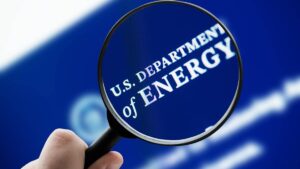Funding, policy certainty are essential to boost gas exploration

Exploration and development funding is needed to stimulate gas exploration. Pic: Getty Images
- Oil and gas sector has seen an uptick in equity capital raisings and M&A activity
- Uncertainty of policy one of the key challenges facing the sector
- Low cost loans to critical minerals should be extended to oil and gas juniors
Argonaut Securities director of equity capital markets Rob Telford says investors are turning back to the under the radar Australian oil and gas sector, which has seen an uptick in both equity capital raisings and M&A activity in recent times.
Since 2023, there has been a 90% uptick in funds raised to $777m and the transactions have increase in size, with Telford pointing to Karoon Energy (ASX:KAR) and Tamboran Resources (ASX:TBN) as examples.
“On the M&A scene, we have seen an uptick as well with $7.7bn last financial year. More recently we have seen Woodside acquire the OCI clean ammonia project ($2.35bn), LNG Japan farming into the Scarborough project for $1.4bn, and Karoon Energy $1.1bn,” Telford told delegates at RIU’s Essential Energy Good Oil Conference in Perth this week.
However, he noted the east coast faced – as widely reported – a looming gas supply deficit due largely to the long-term decline of the Bass Strait.
Telford also warned that while WA wasn’t tracking too badly in terms of gas supply due to the DomGas (domestic gas reservation) policy, it would still start to tail off from 2030 despite new supply coming online.
Boosting exploration
Telford pointed out that one of the industry’s challenges was the uncertainty of policy, citing NSW’s passing of legislation to ban offshore drilling and mining as example, while warning that the Greens were planning to do the same in Victoria.
“I think we need quicker and clearer policy outcomes,” he noted.
“We need more exploration funding … for juniors. It all starts at the drillbit. Development funding for juniors is also important.
“We see a lot of low cost loans in the critical minerals space, I think we need to see more of that in oil and gas. And opening up more onshore and offshore permits to encourage exploration in the sector by offering up more opportunities.”
Funding still available
On equity funding, Telford noted that while large generalist funds have moved away from the sector, specialist resource funds along with sophisticated and retail investors were still investing in oil and gas.
He also pointed to the rise of family offices – essentially high net worth individuals or families – in backing gas.
Debt funding is also changing with Telford pointing that alternative, non-bank lenders were increasingly taking the place of major banks.
He added that more creative ways of funding projects such as royalty financing were also becoming increasingly common and that while farm-outs to larger oil and gas companies have been a norm, he believed there would be more farm-out opportunities to industry end-users looking to secure offtake.
Conference highlights
Following Telford’s speech, no less than three out of eight presenting companies in the first afternoon spoke about their southern African projects.
D3 Energy (ASX:D3E), which is looking to find and produce both natural gas (methane) and helium in South Africa’s Orange Free State, pointed out that while a lot of its peers were drilling deep wells, it drilled low-cost, high-profit shallow wells that had the potential to pay off in months rather than years.
The company, which is currently drilling the RBD12 well, noted that helium was a classic case of demand exceeding supply with managing director David Casey saying current demand growth of 5-6% is double expected supply growth.
He also noted that with South Africa experiencing two or three load shedding events – loss of electricity – on any given day, every single molecule of methane that the company could produce would have a ready market.
This was backed by fellow South Africa-focused play Kinetiko Energy (ASX:KKO), which expressed its belief that it had a potential solution.
Executive chairman Adam Sierakowski said the company was undertaking a really high impact production testing drilling program with the first well expected to spud imminently.
This will flow test and debunk some of the technical risks of the company’s geology and would flow into the significant best estimate (2C) contingent resource of 6 trillion cubic feet of gas.
He added that the company has a joint venture to put about 30 wells into a cluster that will feed a micro-LNG train that can be scaled up.
Meanwhile, Botala Energy (ASX:BTE), which operates the Serowe coalbed methane project in Botswana, is also looking at a mini-LNG plant to deliver the super-cooled gas across the southern border to energy hungry South Africa.
This is in addition to gas sales agreements within Botswana.
Prime Vintage
Other presenters include Vintage Energy (ASX:VEN), which is currently looking to complete and connect the Odin-2 well in South Australia’s Cooper Basin, open up new gas producing zones at its Odin and Vali gas fields as well as establishing gas production at Vali-2.
Odin-2 is expected to be brought online in October with production expected from the Epsilon, Toolachee and Patchawarra formations.
The company is also progressing the all scrip takeover of Galilee Energy (ASX:GLL), which will create a bigger, financially stronger company to progress Odin and Vali.
HyTerra Limited (ASX:HYT) recently scored a coup by attracting a $21.9m strategic investment from Fortescue subject to shareholder approval, which it expects to secure in Q4 2024.
This funding will allow the company to triple both its acreage position in Kansas as well as the planned drill program from two wells to six wells.
Executive director Benjamin Mee added that the company had a very rich funnel of growth opportunities and will jointly screen them with Fortescue.
Meanwhile, private company Ecossaus touched on its plans to leverage established hydrogen storage technology in Australia.
This will see the company construct salt caverns underground that would have their costs largely offset by the production of high purity, pharmaceutical grade sale.
These strategically located salt caverns will be capable of storing significant amounts of green hydrogen produced when renewable energy is at its peak.
Alternatively, these same caverns could also be used for storing carbon dioxide with chief executive officer Dr Eric Lilford flagging that up to 20 billion cubic metres of the greenhouse gas could be stored within 10km2 of its acreage.
This is a small fraction of the ~10,000km2 of granted mineral exploration and gas storage exploration licences it holds in known salt provinces.
At Stockhead, we tell it like it is. While D3 Energy and HyTerra are Stockhead advertisers, they did not sponsor this article.
Related Topics

UNLOCK INSIGHTS
Discover the untold stories of emerging ASX stocks.
Daily news and expert analysis, it's free to subscribe.
By proceeding, you confirm you understand that we handle personal information in accordance with our Privacy Policy.








